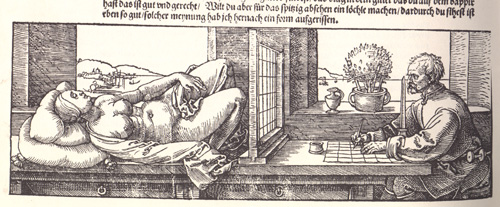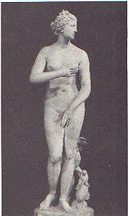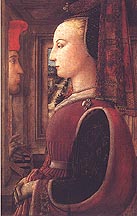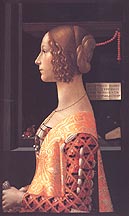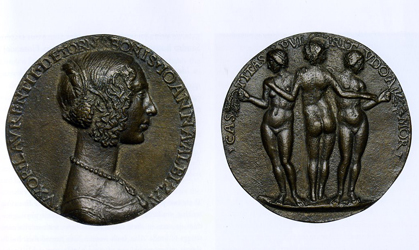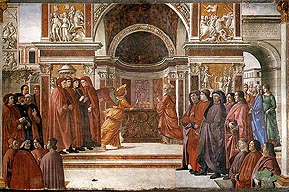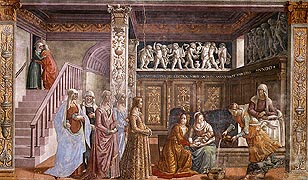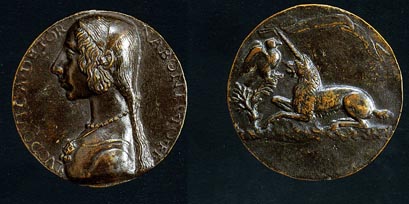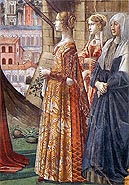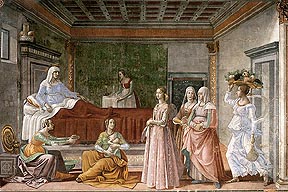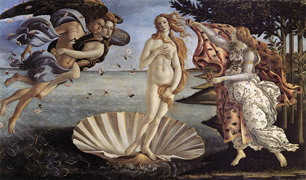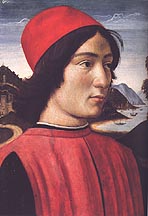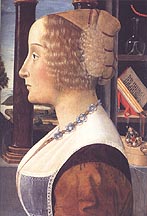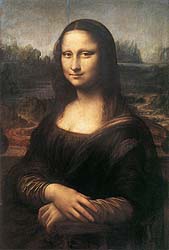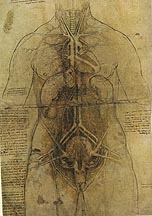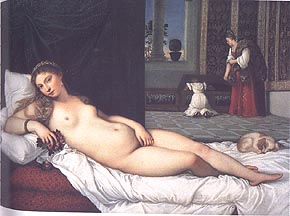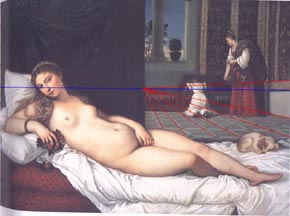ARTH Courses | ARTH 213 Assignments
Images of Women
Masaccio, Expulsion of Adam and Eve, from the Brancacci Chapel.
Medici Aphrodite, original Greek, 4th c. B.C.
Simone Martini, Annunciation, c. 1333.
Wedding Procession, mid-fifteenth century.
Fra Filippo Lippi, Woman with a Man at a Window, c. 1438/1444. Arms at the bottom left are of the Scolari family. Lorenzo di Ranieri Scolari married Angiola di Bernardo Sapiti in 1436. Their son was born in 1444.
Domenico Ghirlandaio, Giovanna degli Albizzi Tornabuoni, 1488/ 90. Giovanna married Lorenzo Tornabouni on June 15, 1486. She gave birth to a son, Giovanni, in October of 1487, and she died in childbirth in October of 1488The cartellino on the back wall is adapted from an epigram by the Roman poet Martial. It can be translated as:
"Art, would that you could represent character and mind. There would be no more beautiful painting on earth."
attributed to Niccolò Fiorentino, Giovanna degli Albizzi Tornabuoni, c. 1486. Inscription on the obverse reads: "Uxor Laurentiii de Tornabonis. Ioanna Albiza (the wife of Lorenzo Tornabuoni, Giovanna Albizzi; Inscription on the reverse : Castitas Pulchritudo Amor (Chastity, Beauty, Love).This is a variation on a medal made for the humanist Pico della Mirandola which also had the Three Graces on the reverse. That inscription read: "Pvlchritudo Amor Volvptas" "Love is passion aroused by beauty"
Frescoes from the Tornabouni Chapel:
Cappella Maggiore, Santa Maria Novella, 1485-90. Commissioned by Giovanni Tornabouni. Painted by Domenico Ghirlandaio. Excerpt for the Contract for the Chapel: "to the praise, magnitude, and honour of Almighty God and His glorious Mother, ever Virgin, and of St John, St Dominic and other saints as detailed below, and of the whole host of heaven, the magnificent and noble Giovanni, son of Francesco Tornabuoni, citizen and merchant of Florence, has proposed, as patron of the greater chapel in the church of S. Maria Novella in Florence, to decorate the said chapel with noble, worthy, exquisite and decorative paintings at his own expense as an act of piety and love of God, to the exaltation of his house and family and the enhancement of the said church and chapel."
Ghirlandaio, Annunciation to Zacharias.An inscription on the arch at the right proclaims that in the year 1490 the city of Florence, made beautiful by works of art and architecture, enjoyed wealth, health and peace. Cristoforo Landino, Agnolo Poliziano and Marsilio Ficino, the intellectual protagonists of Medicean Florence, are included among the portraits as the living proofs of Florence's cultural glory and superiority.
Birth of the Virgin.
Detail of the Birth of the Virgin showing Ludovica Tornabuoni, daughter of Giovanni Tornabouni.
attributed to Niccolò Fiorentino, Ludovica Tornabuoni, 1485 /86.
Visitation.
detail of the Visitation showing Giovanna degli Albizzi Tornabouni.
Birth of John the Baptist. Second figure from the right has been identified as Lucrezia Tornabuoni sister of Giovanni Tornabuoni. Lucrezia was the wife of Piero de Medici and the mother of Lorenzo the Magnificent.
Sandro Botticelli, The Birth of Venus, c. 1484-86.
attributed to Domenico Ghirlandaio, Double Portrait of a Man and a Woman. c. 1490.
Vasari in his Lives includes the following entry:
| For Francesco del Giocondo Leonardo undertook to execute the portrait of his wife, Mona Lisa. He worked on this painting for four years, and then left it still unfinished; and today it is in the possession of King Francis of France, at Fontainebleau... |
Excerpts from the Notebooks of Leonardo:
A good painter has two chief objects to paint, man and the intention of his soul; the former is easy, the latter hard, because he has to represent it by the attitudes and movements of the limbs.... The most important consideration in painting is that the movements of each figure expresses its mental state, such as desire, scorn, anger, pity, and the like. [Compare to the inscription on the cartellino in the Giovanna degli Albizzi Tornabouni portrait by Ghirlandaio: "Art, would that you could represent character and mind. There would be no more beautiful painting on earth."]
Man has been called by the ancients a lesser world and indeed the term is well applied. Seeing that if a man is composed of earth, water, fire, and air, this body of earth is similar. While man has within himself bones as a stay and framework for the flesh, the world has stones which are the supports of earth. While man has within him a pool of blood wherein the lungs as he breathes expand and contract, so the body of the earth has its ocean, which also rises and falls every six hours with the breathing of the world; as from the said pool of blood proceed the veins which spread their branches through the human body so the ocean fills the body of the earth with an infinite number of veins of water.... The cause which moves the water through its springs against the natural course of its gravity is like that which moves the humours in all the shapes of animated bodies.
Note the motion of the surface of the water which conforms to that of the hair, which has two motions, of which one responds to the weight of the strands and the other to the direction of the curls....
Thus, without rest it [water] is ever removing and consuming her borders. So at times it is turbulent and goes raving in fury, at times clear and tranquil it flows playfully with gentle course among fresh meadows. At time it falls from the sky in rain or snow or hail, at times forms great clouds of fine mist.
Oh Time, who consumes all things! Oh envious age, you who destroy all things and devour all things with the hard teeth of the years, little by little, in slow death! Helen, when she looked in her mirror, seeing the withered wrinkles in her face made by old age, wept, and thought to herself, why ever had she been twice ravished. Oh Time, who consumes all things! Oh envious age, by whome all things are consumed!
O marvelous science [i.e. painting], which can preserve alive the transient beauty of mortals and endow it with a permanence greater than the works of nature; for these are subject to continual changes of time, which leads them to inevitable old age. And such as science is in the same relation to divine nature as its works are to the works of nature, and for this it is to be adored.
Raphael, Woman with a Unicorn.
